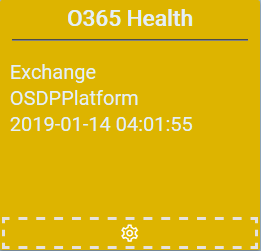CURE - Detector Office365 Health
CURE - The homebrewed monitoring solution. Read more about it in my previous posts:
- CURE-Design
- CURE-Environment
- CURE-Database design
- CURE-Detector foundation
- CURE-Detector-step-by-step
- CURE-GUI
Background
If you’re familiar with Office 365 as an admin, you also are aware that all communication regarding current incidents with the service is done through Sevice Status in the admin portal. So, events communicated are basically custom per tenant and therefore only accessible when authenticated. I wanted to put the current service status up on the CURE display, in order for IT so quickly see the current status of the platform and all its services.
I will describe the steps I did for setting up a CURE detector for monitoring the company tenant Office 365 health based on the DetectorTeamplate.ps1 described in CURE-Detector foundation and the instructions in CURE-Detector-step-by-step. The whole detector script can be found here
Approach
I found this article by Lazy Exchange Admin, that really helped me get going. Since health information is published per Office 365 tenant, I needed to authenticate to the company tenant through Microsoft Graph in order to get our custom health information, and the guide was very helpful in setting that up. The Office 365 Management APIs unfortunately, at the time of writing, is not very good to work with, and I had to put in way more effort and code to get what I wanted than anticipated from this simple task.
LOCAL SETTINGS, FUNCTIONS AND DEPENDENCIES
$detectorName = "O365 Health"
$greenAlerts = @("FalsePositive","ServiceRestored","ServiceOperational","Service restored","False positive","Service operational")
$redSeverity = @("Critical","High","Sev0","Sev1")
$forceGreen = @("SomeIssueIDtoSupress1","SomeIssueIDtoSupress2","SomeIssueIDtoSupress3")
$ClientSecret = Receive-Credential -SavedCredential "MyO365Secret" -Type ClearText
$ClientID = "MyClientIDGUID"
$tenantdomain = "MyO365tenant"
function Get-O365Health {
[CmdletBinding()]
param ([Switch]$AllMessages,[string]$ID),[String]$ClientSecret,[string]$ClientID,[string]$tenantdomain)
begin
{
$body = @{grant_type="client_credentials";resource="https://manage.office.com";client_id=$ClientID;client_secret=$ClientSecret}
$oauth = Invoke-RestMethod -Method Post -Uri "https://login.microsoftonline.com/$($tenantdomain)/oauth2/token?api-version=1.0" -Body $body
$headerParams = @{'Authorization'="$($oauth.token_type) $($oauth.access_token)"}
}
process
{
if ($AllMessages)
{
Return (Invoke-RestMethod -Uri "https://manage.office.com/api/v1.0/$($tenantdomain)/ServiceComms/Messages" -Headers $headerParams -Method Get)
}
elseif ($ID)
{
Return (Invoke-RestMethod -Uri "https://manage.office.com/api/v1.0/$($tenantdomain)/ServiceComms/Messages?ID=$ID" -Headers $headerParams -Method Get)
}
else
{
Return (Invoke-RestMethod -Uri "https://manage.office.com/api/v1.0/$($tenantdomain)/ServiceComms/CurrentStatus" -Headers $headerParams -Method Get)
}
}
}
In the Local Settings section, on rows 2-3 I define arrays with statuses that are to be considered “green” or “red”. Since I have not been able to find such lists of statuses, I needed to compile it by heart and will probably need to update them continuously. On row 4 I keep an array of incident IDs to force green, it usually is problems with services we don’t use, or incidents that doesn’t concern us. I suspect this list will grow over time, and I also may need to move it a more dynamic approach, maybe even an “Acknowledge” button in the CURE UI. But that’s for a future version. For now, we just add incident IDs to this array to suppress them. On rows 5-7 I set the tenant specific stuff and on rows 8-32 there’s a simple function to extract event data with the Microsoft Management API.
CONNECT AND COLLECT
<# this is custom #>
try {$status = Get-O365Health -ClientSecret $ClientSecret -ClientID $ClientID -tenantdomain $tenantdomain -EA stop -WA silentlycontinue}
catch {
$localEvent.descriptionDetails = $_
$localEvent.status = 'grey'
$localEvent.eventShort = "Unable to connect to O365 Health API"
$Disconnected = $True
}
In the CONNECT AND COLLECT section of the script I use my Get-O365Health function to retrieve the current Office 365 health status.
ANALYZE
<# this is custom #>
If (!$Disconnected)
{
$incidents = $status.value | where {$_.status -notin $greenAlerts}
if (!$incidents)
{
$localEvent.status = 'green'
$localEvent.eventShort = "$(Get-ItemCount $status.value) services OK"
}
else
{
$report = @()
$messages = Get-O365Health -AllMessages -ClientSecret $ClientSecret -ClientID $ClientID -tenantdomain $tenantdomain
foreach ($i in $incidents.IncidentIds)
{
$report += ($messages.value | where {$_.id -eq $i}) | select `
@{n="Id";e={$_.id}},`
@{n="Title";e={$_.Title}},`
@{n="State";e={$_.Status}},`
@{n="Workload";e={$_.Workload}},`
@{n="ActionType";e={$_.ActionType}},`
@{n="Classification";e={$_.Classification}},`
@{n="Feature";e={$_.Feature}},`
@{n="ImpactDescription";e={$_.ImpactDescription}},`
@{n="LastUpdatedTime";e={([datetime]$_.LastUpdatedTime).ToString()}},`
@{n="StartTime";e={([datetime]$_.StartTime).ToString()}},`
@{n="Severity";e={$_.Severity}},`
@{n="Status";e={$null}}
}
foreach ($e in $report)
{
if (($e.Id -in $forceGreen) -or ($e.State -in $greenAlerts)) {$e.status = "green"}
elseif ($e.Severity -in $redSeverity) {$e.status = "red"}
else {$e.status = "yellow"}
}
$localEvent.descriptionDetails = ($report | sort status | ConvertTo-Json)
$localEvent.contentType = "json"
if ($report.status -contains "red") {$localEvent.status = "red"}
elseif ($report.status -notcontains "yellow") {$localEvent.status = "green"}
else {$localEvent.status = "yellow"}
if ((($report | where {$_.status -notlike "green"}).Workload | select -Unique).count -le 4) {$localEvent.eventShort = "$((($report | where {$_.status -notlike "green"}).Workload | select -Unique) -join ', ')"}
else {$localEvent.eventShort = "$((($report | where {$_.status -notlike "green"}).Workload | select -Unique).count) Workloads with issues"}
if ($report.count -eq 1) {$localEvent.eventShort = "$($report.workload), $($report.LastUpdatedTime)"}
else {$localEvent.eventShort += ", $(($report.LastUpdatedTime | sort -descending)[0])"}
}
}
In the ANALYZE section of the script, on row 4, I filter out the incidents I want to process. On rows 5-9 I handle the scenario where there are no active alerts (yea right, hasn’t happened so for, seems there is always something broken over at Redmond). On rows 11-45 I handle the scenario where there are active alerts. Since the API is kind of crappy, and I have not found a way to get filtering of incidents to work, I need to download all messages in order to extract the details of the active incidents collected. On rows 14-29 I loop through the $incidents and match it to an actual message, create an event object with the information I need and add it to $report. On rows 30-35 I loop through the $report object to set statuses for each incident. On rows 36-44 I finally set the over all status and populate the $localEvent object, making it ready to be shoved into the CURE database. Worth noticing, on rows 41-42 I truncate how many broken services to be displayed in the CURE UI. Since there sometimes are many broken services over at Redmond, I limit the number to spell out to 4 to not break the UI.
Result
Here’s how the detector would look in the UI with a couple of active incidents (during the last 2 months, I have seen it green only once…)

And if you click the headline you get the details of the current incidents.

The personal experiences, viewpoints and opinions expressed in this blog post are my own and in no way represent those of the company.
